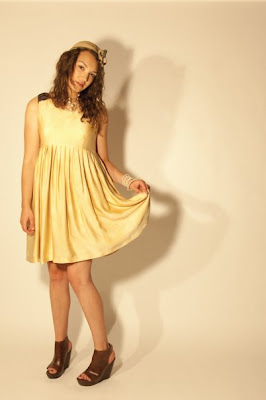I totally regret missing out on the Design_Download Project/Competition run by SHOWstudio not-so-long ago (Did they run it over the course of 6 or 7 years?), and have managed to dig up a complete listing of links to the designer patterns available to download and customise. (And got completely lost in the behemoth that is the SHOWstudio website along the way, which was rather pleasurable.)
Now you can not only own something of the genius of the late McQueen, or the retired Margiela, or Junya, or Yohji, or Galliano, you can also make it your own... (Or you could simply download everything and have a mad pattern-mash-up party with your crazy pattern-making-loving friends)...How incredibly inspirational and great is this?
Thank you Jamie McLaren!
Excerpt from:
http://www.run-riot.com/noticeboard?q=node/2920
Author: Jamie McLaren
Choose from 7 SHOWstudio design_downloads
Designer: Yohji Yamamoto
Pattern: Jacket
Link:
http://www.showstudio.com/projects/ddl_yamamoto/download.html
Renowned for the simple appearance of his designs, coupled with the sophistication of their construction, Yohji Yamamoto has accrued numerous awards over his distinguished 40-year career. This jacket was the first to feature in SHOWstudio’s design_download project, and the basic block can be added to and re-worked to produce an incredible variety of final garments.
Designer: John Galliano
Pattern: Pirate Jacket (Autumn/Winter 2001)
Link:
http://www.showstudio.com/projects/unf/unf_start.html
John Galliano's jacket appeared in his Autumn/Winter 2001 Pirates collection. Within that context, Galliano’s creation referenced historical heroines such as pirate Ann Bonney and Marriane, Delacroix's draped allegorical figure in the painting, 'Liberty Leading the People'. The garment also spoke of the re-cyclical nature of rebel clothing, a constant theme within Galliano’s work since his graduate collection in 1983. Deceptively unconstructed, the jacket appears to be held together by sail rivets, buckles and ties. Galliano’s offering is in fact a complicated garment, and exists as a multifaceted and symbolic piece of corsetry and skilled tailoring.
Designer: Maison Martin Margiela
Pattern: ‘Unfinished Pattern’
Link:
http://www.showstudio.com/projects/ddl_margiela/info.html
Maison Martin Margiela contributed an ‘unfinished pattern’ to the SHOWstudio design_download series. The partially completed simple shift dress plays on ideas of deconstruction, a constant feature of the label since its beginnings in 1988. The ‘unfinished pattern’ is a witty take on the idea of garment patterns – questioning at what point in the design process does a dress actually become a dress.
Designer: Alexander McQueen
Pattern: Kimono Jacket (Autumn/Winter 2003)
Link:
http://www.showstudio.com/projects/ddlmcqueen/download.html
Alexander McQueen allowed SHOWstudio viewers to examine this pattern for his kimono-inspired jacket from the Autumn/Winter 2003 collection. The brutally sharp tailoring, for which this label is synonymous, is seen in the jacket’s strong linear construction and carefully layered fabric sections. A collision of Western Victoriana and Eastern traditional dress, this work, like so much of McQueen’s work, references historical detailing, whilst remaining quintessentially modern.

Designer: Antony Price
Pattern: The Macaw Dress (Spring/Summer 1989)
Link:
http://www.showstudio.com/projects/antonypriceforyourpleasure/patterndow...
Selected from Antony Price's Spring/Summer 1989 collection and dubbed 'The Macaw' by its creator, due to the shard-like taffeta tail-feathers with which the dress is adorned. Price’s designs are glamorous, dramatic and provocative with a focus on eveningwear and theatrical spectacle.
Designer: Junya Watanabe
Pattern: Dress (Autumn/Winter 2005)
Link:
http://www.showstudio.com/projects/dressmeupdressmedown/download/
Junya Watanabe is renowned for his avant-garde style, in particular, his exploration of new cutting concepts, his ingenious sourcing of fabrics and innovative draping techniques. Watanabe’s submission, a dress from his Autumn/Winter 2005 collection, played with ideas of Edwardian elegance, minimalist restraint, and 1950s form. This is seen in the woven plaid circle skirt which creates a strong contrast to the tight fitting bodice in red vinyl, showing the designer interpreting a Punk aesthetic. SHOWstudio viewers played with these notions, producing garments that, at one end conveyed gothic-fairytale glam, and at the other, showcased the dress in sweet ‘50s polka dot, both far cries from the Japanese designer’s famous ‘heavy-duty couture’.
Designer: Gareth Pugh
Pattern: Balloon
Link:
http://www.showstudio.com/projects/fashoff/download/
Rather than submitting a traditional garment pattern to the design_download series, Gareth Pugh chose to contribute a pattern for a balloon which he had previously created. The bold, red and white striped beach-ball fabric balloons are, like much of Pugh’s designs, inspired by shape, proportion and process. There have been various interpretations submitted by SHOWstudio viewers including a giant pin-cushions, lace balloons, and even in a few select instances, items to wear.
































